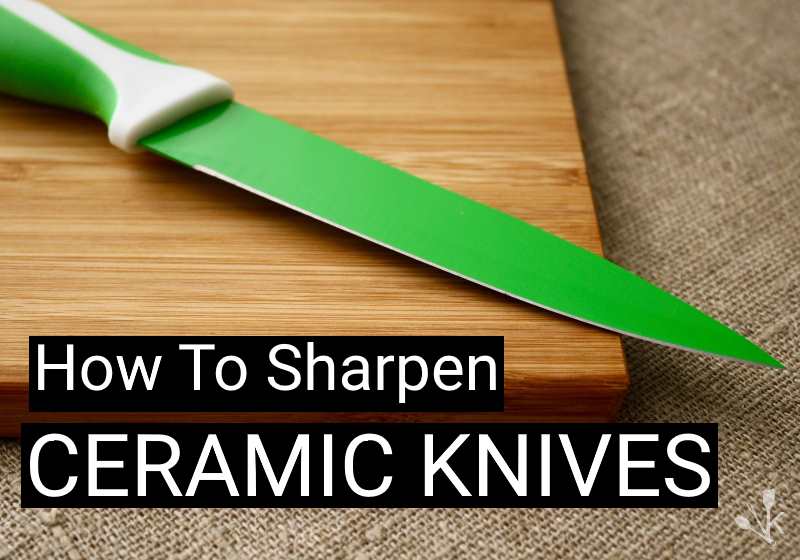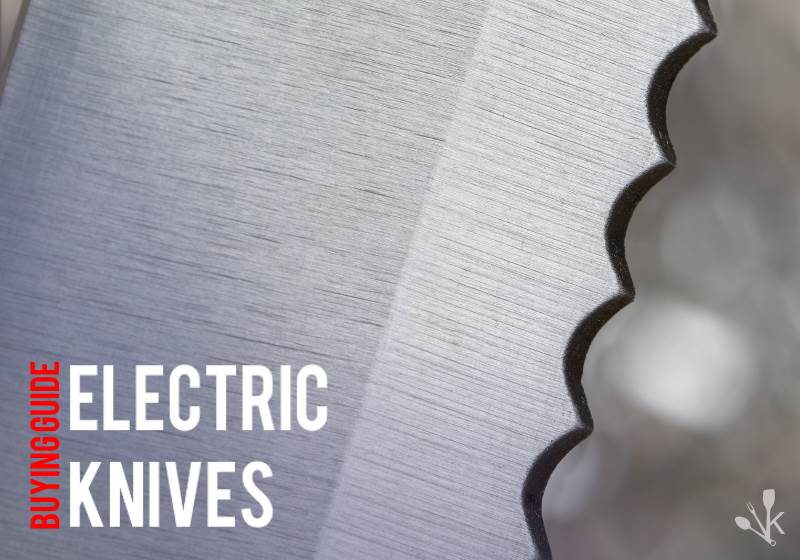Ceramic knives can be a great addition to your kitchen. They are easy to clean, low maintenance and stay razor sharp for a lot longer than steel knives. The downside is that ceramic knives are very brittle and can easily develop small chips or nicks, even when used carefully.
Many people buy a ceramic knife with the misconception that it will never need sharpening. Unfortunately, that’s not true. While they can maintain an edge up to ten times longer than a steel knife, at some point, you will need to sharpen your ceramic knife.

Some ceramic knife manufacturers, such as Kyocera, offer free lifetime professional sharpening, but this isn’t always practical – you have to cover the cost of postage and live without your knife for a period of time.
Can You Sharpen Ceramic Knives?
While sharpening a ceramic knife is possible, it isn’t straightforward. You can’t simply whip out your generic sharpening rod or whetstone and quickly restore that razor sharp edge.
This is because ceramic knives are made from zirconium oxide, which is very hard and brittle – it’s much easier to chip or even snap than a steel blade.
Luckily, if you’re willing to put in a bit of time and effort, you can sharpen your ceramic knives at home. You will need to have patience and a gentle hand – if you’re too rough or use the wrong technique, you can end up adding more micro-chips to the blade.
Because zirconium oxide is so hard, you will need to use an even harder material when sharpening ceramic knives. The best material is diamond.
You can buy electric sharpeners or manual knife sharpeners specifically designed for ceramic knives. They may not get your edge razor sharp but will restore enough sharpness to make it effective in your kitchen. If you decide to buy one of these sharpeners, make sure it has a diamond sharpening wheel.
If you enjoy a bit of hands-on, do-it-yourself time, then using a diamond stone to sharpen your ceramic knives is the best method. It’s a time-consuming process, and you’ll need to work through various different grits, but the end result will be a ceramic knife that is as good as new.
What You Will Need
- Towel or wet paper towel
- Diamond stones – 200 grit, 600 grit, 1000 grit, 1500 grit
- Water – either a spray bottle or a container filled with water deep enough to submerge your diamond stone
How To Sharpen A Ceramic Knife
Because ceramic knives are so brittle, be prepared for a long, methodical sharpening process. You will need to be very gentle with your knife and take care not to push too hard and exert too much force, causing it to chip or snap completely.
If the knife has small chips or nicks in the blade, you will need to start with a lower grit diamond stone, around 200 grit. This is a coarser stone which will remove material more quickly.
After you’ve finished the process with the 200 grit diamond stone, you will need to repeat it again with a higher grit, working your way up until you have completed refining and finishing the blade with a 1500 grit stone.
- Submerge your diamond stone/s in the water for just a few seconds before using, or spray the surface of the stone with water from a spray bottle.
- Dampen a paper towel, sponge, or kitchen towel and place it on a countertop or table to create a non-slip surface. Double check that it is indeed stable before beginning the sharpening process.
- Place your diamond stone on the damp towel.
- Take your knife in your dominant hand and face the tip away from you – very gently place the edge on the whetstone at 90-degrees – be careful not to push down – and then find your ideal angle. For a ceramic knife, this will be 20 degrees or less.
- Keep one hand on the handle and place the fingers of your other hand in the middle of the flat side of the blade – be careful to keep fingers away from the sharp (or soon-to-be-sharp) edge.
- Slide the blade down the stone away from you, but apply minimal downwards pressure. Force is not your friend here, only gentle, repetitive movements and a constant angle. Make sure you sweep the entire length of the blade down the stone.
- Once you’ve finished the first sweep, lift the blade up, bring it back towards you and repeat – always move in the same direction, don’t drag the blade back and forth along the stone.
- Repeat the movement on the same side six times.
- Flip your knife over and repeat six times on the other side.
- Repeat this process with progressively higher grit diamond stones until complete.
SEE ALSO: How To Sharpen Serrated Knives











